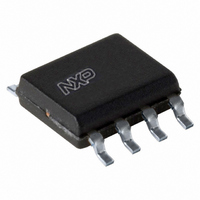TEA1742T/N1,118 NXP Semiconductors, TEA1742T/N1,118 Datasheet - Page 7

TEA1742T/N1,118
Manufacturer Part Number
TEA1742T/N1,118
Description
IC CTRLR GREENCHIP PFC 8-SOIC
Manufacturer
NXP Semiconductors
Series
GreenChip™r
Datasheet
1.TEA1742TN1118.pdf
(17 pages)
Specifications of TEA1742T/N1,118
Mode
Continuous Conduction (CCM)
Frequency - Switching
125kHz
Current - Startup
60µA
Voltage - Supply
10.6 V ~ 38 V
Operating Temperature
-20°C ~ 150°C
Mounting Type
Surface Mount
Package / Case
8-SOIC (3.9mm Width)
Lead Free Status / RoHS Status
Lead free / RoHS Compliant
Other names
935288647118
Available stocks
Company
Part Number
Manufacturer
Quantity
Price
Company:
Part Number:
TEA1742T/N1,118
Manufacturer:
TI
Quantity:
1 870
NXP Semiconductors
TEA1742T_1
Objective data sheet
7.2.2 Valley switching and demagnetization (PFCAUX pin)
7.2.3 Frequency limitation
7.2.4 Mains voltage compensation (VINSENSE pin)
7.2.5 Soft start-up (pin PFCSENSE)
The PFC MOSFET is switched on after the transformer is demagnetized. Internal circuitry
connected to the PFCAUX pin detects the end of the secondary stroke. It also detects the
voltage across the PFC MOSFET. The next stroke is started if the voltage across the PFC
MOSFET is at its minimum in order to reduce switching losses and ElectroMagnetic
Interference (EMI) (valley switching).
If no demagnetization signal is detected on the PFCAUX pin, the controller generates a
Zero Current Signal (ZCS), 50 ms (typ) after the last PFCGATE signal.
If no valley signal is detected on the PFCAUX pin, the controller generates a valley signal
4 ms (typ) after demagnetization was detected.
To protect the internal circuitry, for example during lightning events, it is advisable to add a
5 k series resistor to this pin. To prevent incorrect switching due to external disturbance,
the resistor should be placed close to the IC on the printed circuit board.
To optimize the transformer and minimize switching losses, the switching frequency is
limited to f
limit, the system switches over to discontinuous conduction mode. Also here, the PFC
MOSFET is only switched on at a minimum voltage across the switch (valley switching).
The mathematical equation for the transfer function of a power factor corrector contains
the square of the mains input voltage. In a typical application this results in a low
bandwidth for low mains input voltages, while at high mains input voltages the Mains
Harmonic Reduction (MHR) requirements may be hard to meet.
To compensate for the mains input voltage influence, the TEA1742T contains a correction
circuit. Via the VINSENSE pin the average input voltage is measured and the information
is fed to an internal compensation circuit. With this compensation it is possible to keep the
regulation loop bandwidth constant over the full mains input range, yielding a fast transient
response on load steps, while still complying with class-D MHR requirements.
In a typical application, the bandwidth of the regulation loop is set by a resistor and two
capacitors on the PFCCOMP pin.
To prevent audible transformer noise at start-up or during hiccup, the transformer peak
current, I
inserting R
An internal current source charges the capacitor to V
voltage is limited to V
The start level and the time constant of the increasing primary current level can be
adjusted externally by changing the values of R
softstart
DM
sw(PFC)max
SS1
, is increased slowly by the soft start function. This can be achieved by
=
and C
3
R
. If the frequency for quasi-resonant operation is above the f
SS1
SS1
start(soft)PFC
Rev. 01 — 10 February 2009
between pin PFCSENSE and current sense resistor R
C
SS1
.
SS1
and C
PFCSENSE
SS1
.
GreenChip PFC controller
= I
start(soft)PFC
TEA1742T
© NXP B.V. 2009. All rights reserved.
R
SENSE1
sw(PFC)max
SS1
. The
7 of 17
.















